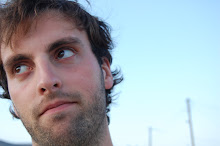 |
| An innocent enough looking puffin... |
Home to puffins, peregrines and petrels,
ravens, razorbills and wrens, shearwaters, shellduck and shags, gannets,
guillemots and gulls it is clear that birds find Skokholm an attractive place
to live. Yet despite being thought of as chiefly an avian island we soon
discovered many of the other beasts that reside there.
Glistening sea gooseberries, formidable
spider crabs and baby pollack navigated the kelp forest in the calm waters of
the landing bay. Wearing nothing more than a pair of pink and brown,
Hawaiian-style boardies I braced myself and leapt into this cold underwater
jungle. Within minutes a curious, young, grey seal began circling beneath me.
Through my misted goggles I could just about make out her ghostly, white
blotched belly, however, just like females of my own species, she kept her distance
from my strange, white, gangly physique.
We found no less than twenty-six individual slow worms tangled up and basking
under sheets of corrugated iron near to our camp and I nearly squashed the
first recorded cinnabar moth of the year as it dozed in the sun on a clump of wind-swept
sea campion. The island was teeming with life of all shapes and sizes.
However, over the course of our visit it felt as though the avian inhabitants of this rocky outcrop were becoming increasingly hostile towards our mammalian invasion. It was on our third day that the first of a trilogy of attacks began.
 |
| Clearly a beast of a slow worm! |
However, over the course of our visit it felt as though the avian inhabitants of this rocky outcrop were becoming increasingly hostile towards our mammalian invasion. It was on our third day that the first of a trilogy of attacks began.
 |
| Perhaps it mistook that hair cut for a tasty rabbit..? |
The second attack came under the cover of darkness. I had ventured out of my room to answer a call of nature. As I stumbled around I could hear the eerie sound of thousands of Manx shearwaters returning from a day’s fishing over the Atlantic. I had just finished providing the nettles with their periodic dose of nitrates when a kamikaze shearwater flew silently but rapidly into the side of my head. The sensation was not indifferent to the combined shock and pain experienced when walking into a lamp post (trust me I’ve been that victim... twice). I held my, now throbbing, right ear and just about heard the shocked murmurings of an embarrassed Manxie as it crashed into the freshly hydrated nettles. It wasn't there the next morning so I can only hope it found its burrow before the gulls found it.
 |
| One sand-eel sticky (and stinky) bomb. |

No comments:
Post a Comment